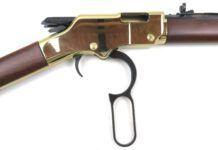The plinking/light-target .22 LR autoloader rifle market has long been one of the gun industry’s mainstays; it seems there’s an almost bottomless need for entry-level .22s that shoot well enough, function well enough, and don’t cost too much. In recent years, Ruger has reportedly had the best of the segment, selling ten versions of its venerable 10/22 design, which was introduced in 1964, in the price span between $160 to $300. Likewise, at a slightly lower price point, Marlin’s $100 to $160 Model 60s did almost as well, accounting for a good chunk of that firm’s total business, a company source told us. But why wasn’t the biggest name in the business—Remington—better represented in what was likely the most popular product segment?
Unquestionably, Remington hasn’t had a hit in the autoloading .22 rifle market since the Nylon 66, introduced back when dinosaurs roamed the earth in 1959. Like the 10/22 that followed it, the 66’s strengths were durability, reliability, and easy care, if not pinpoint accuracy. With those timeless attributes in mind, Remington went back to the well in 1997 and rolled out the 597-series rifles—which to our eyes were made to correct deficiencies that have gone long overlooked in the unchanged 10/22s.
We say this because of a recent four-way test we undertook to compare two basic 597 guns, the polymer-stocked 597 and wood-stocked 597 Sporter, with two of Ruger’s better sellers, the polymer-stocked 10/22RP and the hardwood-stocked 10/22RB. In terms of price, weight, length, componentry, design, and options, these two lines look like twins separated at birth. It was as if Remington sales guys, a la Dilbert, asked the company’s engineers to “make us a gun that looks like the 10/22, but different, and better.”
Did they succeed? We think so, at least in part.
Range Testing
We got and shot the 597 Sporter, $159, pitting it against the 10/22RB, which carries an MSRP of $225, but which usually sells for $160 to $180 in stores. There was about a half-pound difference in the guns’ weights, with the Ruger being about a half-pound lighter and 2.5 inches shorter than the Remington. Both guns had plain-Jane hardwood stocks. On the plastic side, we paired the 597 and the 10/22RP, which fit in the same price frames and have virtually identical physical dimensions as the other guns. We shot the guns at 50 yards with five brands of ammo, first trying to wring out our accuracy data with the equipped iron sights on each gun, but we finally gave up and mounted a scope and reshot the groups. Without the scope, we simply couldn’t line up the poor open sights with enough precision to fairly compare the guns’ accuracy.
Of course, along the way we also noted what we thought were the strengths and weaknesses of each product, which we report in the text below.
Remington 597, 597 Sporter
Our recommendation: These guns performed on par with the Rugers in some important ways. Moreover, they fix some of the irritating shortcomings that linger in the Ruger design. But they need better mags and improved reliability, in our view. Foremost, of course, the Remingtons had to shoot somewhat accurately, and we found they did, with the plastic-stocked gun recording a best average group size of 0.7 inches at 25 yards with Lapua Dominator, and 0.9-inch groups with Federal UltraMatch. Naturally, it didn’t shoot as well with a non-target load, printing 1.5-inch groups with Remington Viper high-velocity rounds. The Sporter didn’t do as well, however, shooting a best-group average of 1.3 inches with Eley Tenex.
In the hands, the Remingtons showed their strengths. The action operated solidly on both guns, with the bolt sliding forward on two rails. It opened and closed with a solid “snink” sound. Their stocks, which are half an inch longer than the Rugers’, also have a swell in the pistol grip, which felt great. The guns came to shoulder easily and naturally, we thought. The flat forends sat squarely on sandbags, which we appreciated. Though we didn’t see any accuracy advantage in this test, we thought the Remingtons’ free-floated barrels were a good idea. We liked the easy-to-reach magazine release, and we liked that the action stayed open after the last shot.
However, we think the 597s are still works in progress. The plastic 10-round magazines felt cheap and flimsy, and we noted continuing failures to feed in both Remingtons when the magazines were fully loaded. The Dominator and Federal ammos also caused malfunctions, even when the magazines weren’t fully loaded. The heavy trigger on the 597 had a squared edge that was uncomfortable.
Ruger 10/22RP, 10/22RB
Our recommendation: Still the way to go, we think. But the Rugers badly need Remington-like modifications, including a better magazine release and a grooved receiver top.
In terms of accuracy, the 10/22RB and 10/22RP shot more small groups than the 597s, but weren’t dominant, in our view. Both Rugers liked the Lapua ammo, firing 0.8-inch and 0.7-inch average groups, respectively. But they didn’t like the Viper ammo, shooting 1.9-inch and 1.4-inch average groups with that brand.
In these guns, pinpoint accuracy generally takes a backseat to run-dirty reliability, and the Rugers shone in this area. We noted but one failure to feed rounds from the blocky 10-round magazines in the wood-stocked gun. We had more failures to feed in the plastic gun, until we figured out one of the magazines was defective. Once it was eliminated, the gun functioned well.
Beyond these basics, the 10/22 could stand some updating. The magazine releases need to be moved from underneath the guns to the side, like the Remington. The receivers need to be grooved as well, instead of just drilled and tapped. We had a horrible time getting these guns sighted in when installing aftermarket bases. The bolt release is hard to operate, and the stamped piece should be moved and enlarged. The triggers weren’t too good either, and they limited the guns’ ability to shoot groups. The stocks felt light, which is an advantage in some ways, but they didn’t help stabilize the gun. Of the two stocks, we liked the ding-proof qualities of the polymer version better.
Gun Tests Recommends
In our view, Remington has closed the gap with Ruger in this segment and is fielding a competitive, but not obviously better, product. We would stick with Ruger for now, particularly the polymer stocked 10/22RP.




























